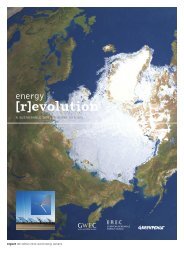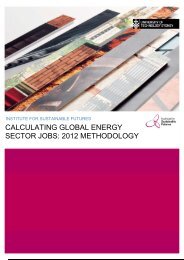download the mexico energy revolution scenario
download the mexico energy revolution scenario
download the mexico energy revolution scenario
You also want an ePaper? Increase the reach of your titles
YUMPU automatically turns print PDFs into web optimized ePapers that Google loves.
image WELDER WORKING AT VESTAS<br />
WIND TURBINE FACTORY,<br />
CAMPBELLTOWN, SCOTLAND.<br />
© KATE DAVISON/GP<br />
climate change and security of supply<br />
Spurred by recent rapidly fluctuating oil prices, <strong>the</strong> issue of security of<br />
supply – both in terms of access to supplies and financial stability – is<br />
now at <strong>the</strong> top of <strong>the</strong> <strong>energy</strong> policy agenda. One reason for <strong>the</strong>se price<br />
fluctuations is <strong>the</strong> fact that supplies of all proven resources of fossil fuels<br />
– oil, gas and coal – are becoming scarcer and more expensive to<br />
produce. So-called ‘non-conventional’ resources such as shale oil have<br />
even in some cases become economic, with devastating consequences for<br />
<strong>the</strong> local environment. What is certain is that <strong>the</strong> days of ‘cheap oil’ are<br />
coming to an end. Uranium, <strong>the</strong> fuel for nuclear power, is also a finite<br />
resource. By contrast, <strong>the</strong> reserves of renewable <strong>energy</strong> that are<br />
technically accessible globally are large enough to provide about six<br />
times more power than <strong>the</strong> world currently consumes – forever.<br />
Renewable <strong>energy</strong> technologies vary widely in <strong>the</strong>ir technical and<br />
economic maturity, but <strong>the</strong>re are a range of sources which offer<br />
increasingly attractive options. These include wind, biomass,<br />
photovoltaics, solar <strong>the</strong>rmal, geo<strong>the</strong>rmal, ocean and hydroelectric power.<br />
Their common feature is that <strong>the</strong>y produce little or no greenhouse gases,<br />
and rely on virtually inexhaustible natural elements for <strong>the</strong>ir ‘fuel’. Some<br />
of <strong>the</strong>se technologies are already competitive. The wind power industry,<br />
for example, continued its explosive growth in <strong>the</strong> face of a global<br />
recession and a financial crisis in 2008 and 2009 and is a testament to<br />
<strong>the</strong> inherent attractiveness of renewable technology.<br />
Last year (2009) Bloomberg New Energy Finance reported <strong>the</strong> total<br />
level of annual investment in clean <strong>energy</strong> as $145 billion, only a 6.5%<br />
drop from <strong>the</strong> record previous year. The global wind industry defied <strong>the</strong><br />
economic downturn and saw its annual market grow by 41.5% over<br />
2008, and total global wind power capacity increase by 31.7% to 158<br />
GW at <strong>the</strong> end of 2009. 4 More grid-connected solar PV capacity was<br />
added worldwide than in <strong>the</strong> boom year of 2008. And <strong>the</strong> economics of<br />
renewables will fur<strong>the</strong>r improve as <strong>the</strong>y develop technically, as <strong>the</strong> price<br />
of fossil fuels continues to rise and as <strong>the</strong>ir saving of carbon dioxide<br />
emissions is given a monetary value.<br />
At <strong>the</strong> same time <strong>the</strong>re is enormous potential for reducing our<br />
consumption of <strong>energy</strong>, and still continuing to provide <strong>the</strong> same level of<br />
<strong>energy</strong> services. This study details a series of <strong>energy</strong> efficiency measures<br />
which toge<strong>the</strong>r can substantially reduce demand across industry, homes,<br />
business and services.<br />
In contrast to <strong>the</strong> explosive growth and promise of renewables and<br />
efficiency, nuclear <strong>energy</strong> is a relatively minor industry with major<br />
problems. The average age of operating commercial nuclear reactors is<br />
23 years, so more power stations are being shut down than started. In<br />
2008, world nuclear production fell by 2 % compared to 2006, and <strong>the</strong><br />
number of operating reactors as of January 2010 was 436, eight less<br />
than at <strong>the</strong> historical peak of 2002. Although nuclear power produces<br />
little carbon dioxide, <strong>the</strong>re are multiple threats to people and <strong>the</strong><br />
environment from its operations. These include <strong>the</strong> risks and<br />
environmental damage from uranium mining, processing and transport,<br />
<strong>the</strong> risk of nuclear weapons proliferation, <strong>the</strong> unsolved problem of<br />
nuclear waste and <strong>the</strong> potential hazard of a serious accident. As a<br />
result, nuclear power is discounted in this analysis.<br />
<strong>the</strong> <strong>energy</strong> [r]evolution<br />
The threat of climate change demands nothing short of an Energy<br />
Revolution – a transformation that has already started, as<br />
renewable <strong>energy</strong> markets exhibit huge and steady growth. In <strong>the</strong><br />
first global edition of <strong>the</strong> Energy [R]evolution, published in January<br />
2007, we projected a global installed renewable capacity of 156<br />
GW by 2010. At <strong>the</strong> end of 2009, 158 GW has been installed.<br />
More needs to be done, however. At <strong>the</strong> core of this <strong>revolution</strong> will<br />
be a change in <strong>the</strong> way that <strong>energy</strong> is produced, distributed and<br />
consumed. The five key principles behind this shift will be to:<br />
<strong>the</strong> five key principles behind this shift will be to:<br />
• Implement renewable solutions, especially through decentralized<br />
<strong>energy</strong> systems<br />
• Respect <strong>the</strong> natural limits of <strong>the</strong> environment<br />
• Phase out dirty, unsustainable <strong>energy</strong> sources<br />
• Create greater equity in <strong>the</strong> use of resources<br />
• Decouple economic growth from <strong>the</strong> consumption of fossil fuels<br />
Decentralized <strong>energy</strong> systems, where power and heat are produced<br />
close to <strong>the</strong> point of final use, will avoid <strong>the</strong> current waste of <strong>energy</strong><br />
during conversion and distribution. Investments in ‘climate<br />
infrastructure’ such as smart interactive grids, as well as super grids<br />
to transport large quantities of offshore wind and concentrating solar<br />
power, are essential. Building up clusters of renewable micro grids,<br />
especially for people living in remote areas, will be a central tool in<br />
providing sustainable electricity to <strong>the</strong> almost two billion people<br />
around <strong>the</strong> world for whom access to electricity is presently denied.<br />
greenhouse development rights<br />
Although <strong>the</strong> Energy Revolution envisages a clear technological<br />
pathway, it is only likely to be turned into reality if its<br />
corresponding investment costs are shared fairly under some kind<br />
of global climate regime. To demonstrate one such possibility, we<br />
have utilized <strong>the</strong> Greenhouse Development Rights framework,<br />
designed by EcoEquity and <strong>the</strong> Stockholm Environment Institute,<br />
as a way of evening up <strong>the</strong> inherently unequal abilities of countries<br />
to respond to <strong>the</strong> climate crisis in <strong>the</strong>ir <strong>energy</strong> polices.<br />
The Greenhouse Development Rights (GDR) framework calculates<br />
national shares of global greenhouse gas obligations based on a<br />
combination of responsibility (contribution to climate change) and<br />
capacity (ability to pay). Crucially, GDRs take inequality within<br />
countries into account and calculate national obligations on <strong>the</strong><br />
basis of <strong>the</strong> estimated capacity and responsibility of individuals.<br />
references<br />
3 JOEL B. SMITH, STEPHEN H. SCHNEIDER, MICHAEL OPPENHEIMER, GARY W. YOHE, WILLIAM<br />
HARE, MICHAEL D. MASTRANDREA, ANAND PATWARDHAN, IAN BURTON, JAN CORFEE-MORLOT,<br />
CHRIS H. D. MAGADZA, HANS-MARTIN FÜSSEL, A. BARRIE PITTOCK, ATIQ RAHMAN, AVELINO<br />
SUAREZ, AND JEAN-PASCAL VAN YPERSELE: ASSESSING DANGEROUS CLIMATE CHANGE<br />
THROUGH AN UPDATE OF THE INTERGOVERNMENTAL PANEL ON CLIMATE CHANGE (IPCC)<br />
“REASONS FOR CONCERN”. PROCEEDINGS OF THE NATIONAL ACADEMY OF SCIENCES.<br />
PUBLISHED ONLINE BEFORE PRINT FEBRUARY 26, 2009, DOI: 10.1073/PNAS.0812355106. THE<br />
ARTICLE IS FREELY AVAILABLE AT: HTTP://WWW.PNAS.ORG/CONTENT/EARLY/2009/02/25/<br />
0812355106.FULL.PDF A COPY OF THE GRAPH CAN BE FOUND ON APPENDIX 1.<br />
4 GLOBAL WIND 2009 REPORT, GWEC, MARCH 2010, S. SAWYER, A. ZERVOS. 9



![Energy [R]evolution - European Commission](https://img.yumpu.com/49109324/1/184x260/energy-revolution-european-commission.jpg?quality=85)


![5905 gp [eu rev]csfr4.qxd - Energy [R]evolution](https://img.yumpu.com/42305023/1/184x260/5905-gp-eu-revcsfr4qxd-energy-revolution.jpg?quality=85)


![5905 gp [eu rev]csfr4.qxd - Energy [R]evolution](https://img.yumpu.com/28729264/1/184x260/5905-gp-eu-revcsfr4qxd-energy-revolution.jpg?quality=85)